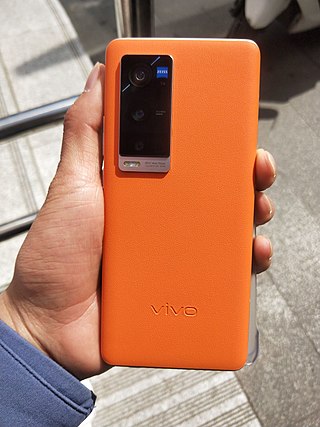Related Research Articles
The following is a comparison of high-definition smartphone displays, containing information about their specific screen technology, resolution, size and pixel density. It is divided into three categories, containing smartphones with 720p, 1080p and 1440p displays.

Android One is a family of third-party Android smartphones promoted by Google. In comparison to many third-party Android devices, which ship with a manufacturer's customized user interface and bundled apps, these devices run near-stock versions of Android with limited modifications, and a focus on Google services. Devices that run Android One receive OS updates for at least two years after their release, and security patches for at least three years.

The Samsung Galaxy A series is a line of low-range to mid-range Android smartphones and tablets manufactured by Samsung Electronics as part of their Galaxy line. The first models in the series were the first-generation Galaxy A3 and Galaxy A5, announced on October 31, 2014 and released in December 2014.

The Samsung Galaxy Jseries is a discontinued line of entry-level 32-bit Android smartphones produced by the South Korean company Samsung Electronics, first introduced in 2015 and focused on emerging markets. This series is a part of Samsung Galaxy series, preceding the current Galaxy M Series and placed below the mid-range Galaxy A Series.
Android Go products were first showcased at MWC 2018 with six products: Nokia 1, ZTE Tempo Go, Alcatel 1X, General Mobile GM8 Go, Lava Z50, and Micromax Bharat Go. The Blu Vivo Go became the first Android Go device with Android Pie Go edition.

The Samsung Galaxy M series is a line of online-exclusive low-range to mid-range budget smartphones manufactured by Samsung Electronics. The first models in the series, the Samsung Galaxy M10 and M20, were released on February 5, 2019; they were followed by the Samsung Galaxy M30 on March 7 and the Samsung Galaxy M40 on June 18. The Galaxy M10s and M30s were announced on September 18, and both were released on September 29. The Galaxy M01 and M11 were released on June 2, 2020 and were available for sale on both online and offline platforms. On September 10, Samsung announced the Galaxy M51, the first upper mid-range model in the lineup.

Huawei Mate 40, Huawei Mate 40 Pro, Huawei Mate 40 Pro Plus and Huawei Mate 40 RS Porsche Design is a high-end Android and HarmonyOS based phablets developed by Huawei for its Mate series, succeeding the Huawei Mate 30 range. They were released on October 22, 2020, at Huawei's Online Global Launch Event.

The Samsung Galaxy Watch series is a line of smartwatches designed and produced by Samsung Electronics. The line features various health, fitness, and fashion related features, and is integrated with Samsung's other products under the Samsung Galaxy brand. The series is the successor to the previous Samsung Gear watches.
The Vivo V19 is an Android-based smartphone manufactured by Vivo Communication Technology Co. The phone was announced and released in April 2020. The phone is highlighted by a quad-camera setup, including a 48 MP main sensor, a 6.44 in (164 mm) Super AMOLED, 1080p display, up to 256 GB UFS 2.1 storage, 8 GB RAM, and a 4500 mAh battery capable of 33 W Vivo Fast Charge 2.0.
The Vivo V3 and V3 Max are Android-based smartphones manufactured by Vivo Communication Technology Co. The phones were released in April 2016.
The Vivo Y3 was launched in May 2019. The Vivo Y3s phone served as an even more budget friendly variant, reducing prices by cutting out the Ultra-wide camera, and launched much later, on October 26, 2020. The pricing for the Vivo Y3 was around €190 (¥1500), and the Vivo Y3s launched with a price of €150 (¥1170).

Vivo X60 is a line of Android-based smartphones developed and manufactured by Vivo, it featured the Zeiss co-engineered imaging system. It was released on January 8, 2021, for the X60 & X60 Pro, January 30, 2021 for the X60 Pro+, and the X60t Pro+ on June 28, 2021.
iQOO Communication Technology Co. Ltd. is a Chinese consumer electronics manufacturer headquartered in Dongguan, Guangdong. The company was founded on 30 January 2019 as a subsidiary of the consumer electronics manufacturer Vivo based in the same city. The brand name iQOO stands for I Quest On and On.

vivo T1(China, Malaysia, India 44W), vivo T1x(5G and 4G), vivo T1 5G(India) and vivo T1 Pro(India, rebranded Malaysian vivo T1) are the 5G Android-based smartphones manufactured by Vivo Communication Technology Co.
References
- ↑ "vivo X30 - Full phone specifications". www.gsmarena.com. Retrieved 2024-12-14.
- ↑ "vivo X30 Pro - Full phone specifications". www.gsmarena.com. Retrieved 2024-12-14.